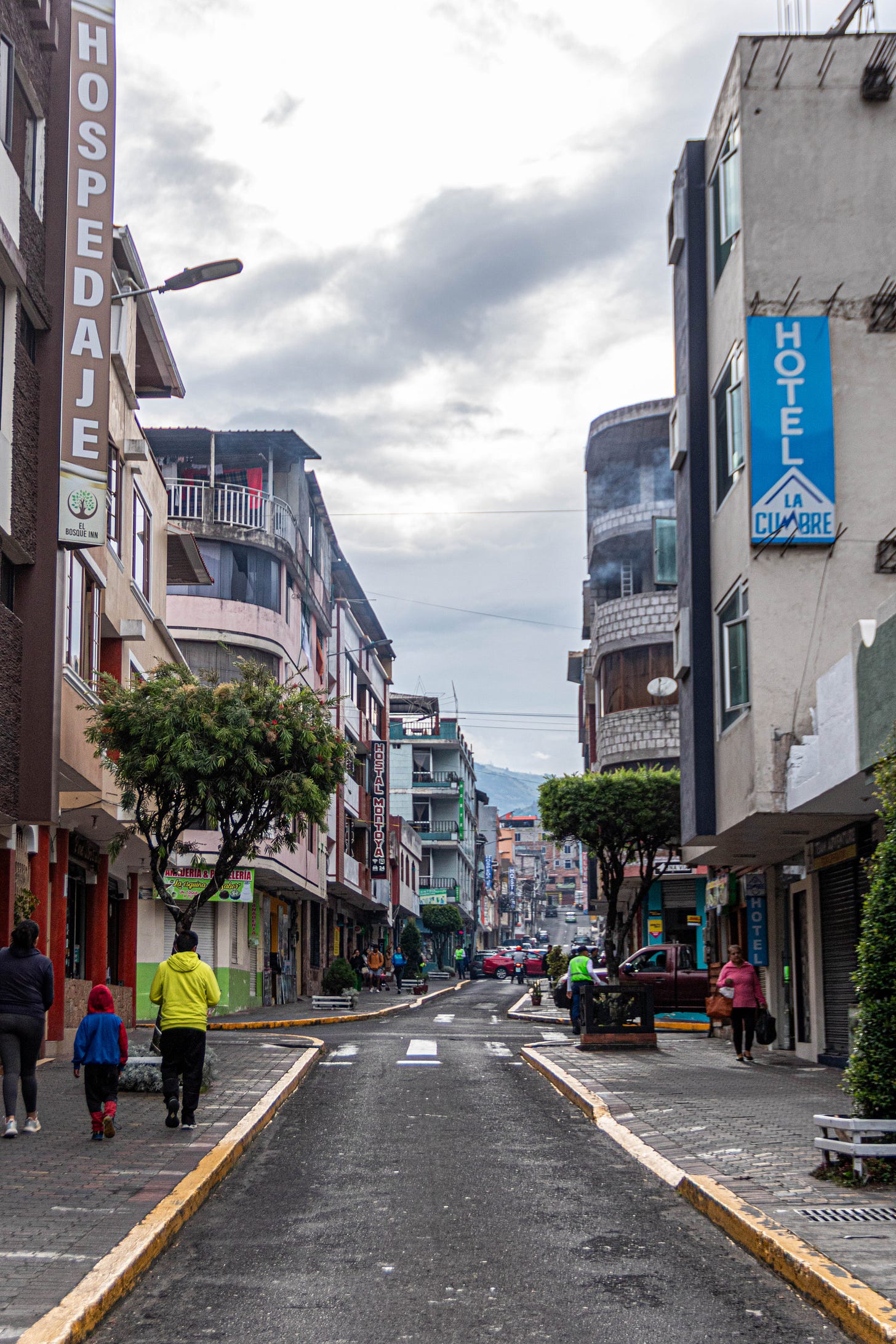Baños de Agua Santa
Holy water, waterfalls, thermal baths, and adventure, in the gateway of the Ecuadorian Amazon
I am in Ecuador with Fernanda. We mainly stay in Riobamba, the city where her family lives. From there, we travel to other cities and parts of the country. We visited Quito, where we saw the old town, Otavalo, Mitad del Mundo and the Basilica del Voto National.
After Quito, we went to Baños, one of Ecuador's most popular tourist destinations, just one hour by bus from Riobamba. We spent three days in the city and visited its surroundings, such as waterfalls and viewpoints.
Baños de Agua Santa, often called Baños, is a small yet vibrant town in the Tungurahua province of Ecuador. Known as the "Gateway to the Amazon," Baños sits at the base of an active volcano, Tungurahua, surrounded by lush green hills, cascading waterfalls, and abundant natural beauty. The town has become one of Ecuador's top destinations for adventure tourism and relaxation, drawing visitors with its unique mix of activities and natural hot springs.
After checking in at the hostel, we visited the main church in the town. For Fernanda’s family, it is a tradition to go there as the first thing when they are in the city.
Sanctuary of Our Lady of the Holy Water is a neo-Gothic church and a prominent feature of Baños and is dedicated to the Virgin of the Holy Water, the town's patron saint. Its importance stems from the belief that the Virgin Mary protects the town from natural disasters, especially the volcanic eruptions of the nearby Tungurahua volcano. Many locals and pilgrims visit this sanctuary to seek the Virgin’s blessings and protection, making it a central part of life in Baños.
Constructed with volcanic stone, the church has a unique, rugged appearance that complements the natural surroundings. The interior is equally impressive, featuring high vaulted ceilings, intricate woodwork, and murals depicting miracles said to have occurred in Baños. The sanctuary’s architecture creates an atmosphere of reverence and grandeur, reflecting its significance to the people of Baños.
We went to the church to light candles as a sign of gratitude and in hopes of blessings, this is Fernanda’s family tradition, but it is also what pilgrims and believers do in Banos. The sanctuary’s ambience is peaceful, inviting moments of quiet reflection and prayer.
After visiting the church, we had a stroll around the city, it was a Sunday and there were lots of people around who came to spend the day there. Walking in the city centre at one point we reached the Cascada de la Virgen, or "The Virgin’s Waterfall," one of the most iconic and sacred waterfalls in Baños. It cascades down from a lush hillside, creating a mesmerizing natural backdrop visible from various spots in Baños. The waterfall gets its name from a local legend, which says that the Virgin Mary appeared at this site, blessing the water with healing properties and protecting the town from volcanic eruptions. Pilgrims, locals, and visitors visit the waterfall seeking blessings, healing, and protection. During religious festivals, particularly during the Feast of the Virgin in October, the waterfall becomes a focal point of community activities and rituals.
Strolling in a city full of people, active, and at one point seeing this waterfall was a great surprise, later in this trip I discovered that Baños is full of waterfalls.
The name "Baños" comes from the town’s natural hot springs, rich in minerals and said to have therapeutic properties. In the evening we went to the Termas de la Virgen, one of the most famous hot spring facilities in Baños. Located at the base of a lush hillside and close to the Cascada de la Virgen, it’s a popular destination for those who are seeking relaxation. The pools are fed by naturally heated water from Tungurahua Volcano, which lends a unique ambience to the bathing experience.
Termas de la Virgen offers a range of thermal pools at varying temperatures, catering to all comfort levels. There are typically three main pools with water temperatures ranging from cool to very hot, allowing visitors to choose or alternate between them to improve circulation and relax sore muscles. The hottest pool is often a striking yellowish colour due to its high mineral content, especially sulfur. A major attraction is a natural waterfall located right by the pools, where some pools have waterfall-fed showers that give bathers a rejuvenating experience with cool mountain water. The soothing sound of the falls also adds to the peaceful atmosphere.
We went to the thermal baths in the evening because the cooler temperatures and dim lighting made the warm pools more inviting, but also because there was a more serene atmosphere, with fewer people and it was cheaper.
After the relaxation in the pools, we had dinner and went to sleep in the hostel, to be ready for the next, intense, day.
See you soon
Flavio


















Quanti posti mi sto segnando per colpa tua eheh